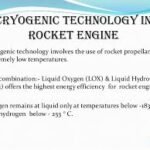What Are Cryogenics Engines: Basics Explained

Cryogenics means
It is the study of the production of materials at extremely cold temperatures. The temperatures studied in cryogenics are those below -243.67 degrees Fahrenheit (120 Kelvin); such low temperatures do not occur in nature. A cryogenic rocket engine is a rocket engine that uses a cryogenic fuel or oxidizer, that is, its fuel or oxidizer (or both) is gases liquefied and stored at very low temperatures.
Thus, all cryogenic rocket engines are liquid engines but they should be distinguished from rocket engines that use earth-storable liquid propellants that are liquids at ordinary temperatures and can, therefore, be stored as liquids easily.
The most common cryogenic propellants used in rocket engines are liquid hydrogen (LH2), which liquefies at −253° C, as the fuel, and liquid oxygen (LOX), which liquefies at −183° C, as the oxidizer.
The most important reason to prefer a cryogenic engine is its efficiency. The cryogenic engine provides more thrust with each kg of propellant it uses compared to other propellant.
Cryogenic propellants are preferred as rocket propellants when rockets have to carry payloads of high mass because they have the greatest efficiency in terms of thrust generated. The advantage of cryogenic propellants is that they are the most energetic and, therefore, have the highest specific impulse. The LOX+LH2 combustion yields the highest amount of total energy and the product of combustion is water vapor, with a low molecular weight.






0 Comments